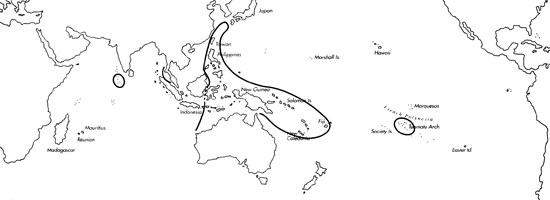
Skip Navigation Links
View access keys for this site.

Range: Okinawa and Philippines to Papua New Guinea and New Caledonia; W. Australia, Mauritius, W. Thailand, and Maldives; probably also in Tuamotu Archipelago and Fiji.
Description: Small to moderately small, light to moderately light. Last whorl usually narrowly ovate to ovate or ventricosely conical; outline usually convex; left side may be concave at base. Shoulder indistinct, sometimes rounded. Spire of moderate height to high, outline sigmoid to convex. Larval shell of 2.75- 3.25 whorls, maximum diameter about 0.70 mm. First 2.5-5 postnuclear whorls tuberculate. Teleoconch sutural ramps flat to slightly convex, with 1 increasing to 3 spiral grooves in early whorls and with weak spiral striae in later whorls. Last whorl with closely spaced fine, weak to distinct spiral ribs from base to shoulder.
| Shell Morphometry | ||
|---|---|---|
| L | 20-36 mm | |
| RW | 0.04-0.10 g/mm | |
| RD | 0.45-0.55 | |
| PMD | 0.71-0.85 | |
| RSH | 0.18-0.26 | |
Ground colour bluish violet, reddish violet in the Indian Ocean. Last whorl with three violet-brown spiral bands, below shoulder, at centre and within basal third. Subcentral band often adapically bordered by dark brown spots. Larval whorls and first 2-3 postnuclear sutural ramps reddish violet. Following sutural ramps with pale brown radial blotches. Aperture whitish violet behind a translucent marginal zone.
Periostracum brown, rather thin, nearly opaque, with interlaced axial ridges.
Habitat and Habits: In 25-240 m, in sand and coral rubble.
Discussion: Before its description, C. granum was sometimes identified as C. luteus or C. tenuistriatus, although these are markedly larger species. C. luteus differs in its more distinct shoulder, largely smooth surface, broader (0.95-1.1 mm) and yellow larval shell, and in colour pattern with brown spiral lines on the last whorl. C. nucleus can be distinguished by its orange to olive-brown colour, largeley smooth surface, and smaller number (1-3 vs. 2.5-5) of weakly rather than distinctly tuberculate early postnuclear whorls; its larval shell is yellow, broader (0.9 mm), and comprises 4 whorls. For comparison with C. tenuistriatus, see the DISCUSSION of this species. Indian Ocean specimens (Pl. 49, Figs. 33-34) differ from typical C. granum (Pl. 49, Figs. 30-32) only in the ground color of their shells; we therefore consider them to represent the same species.

C. granum range map
This section contains verbatim reproductions of the accounts of 316 species of Conus from the Indo-Pacific region, from Manual of the Living Conidae, by Röckel, Korn and Kohn (1995). They are reproduced with the kind permission of the present publisher, Conchbooks.
All plates and figures referred to in the text are also in Röckel, Korn & Kohn, 1995. Manual of the Living Conidae Vol. 1: Indo-Pacific Region.
The range maps have been modified so that each species account has it own map, rather than one map that showed the ranges of several species in the original work. This was necessary because each species account is on a separate page on the website and not confined to the order of accounts in the book.
Return to framed version (returns to search page)